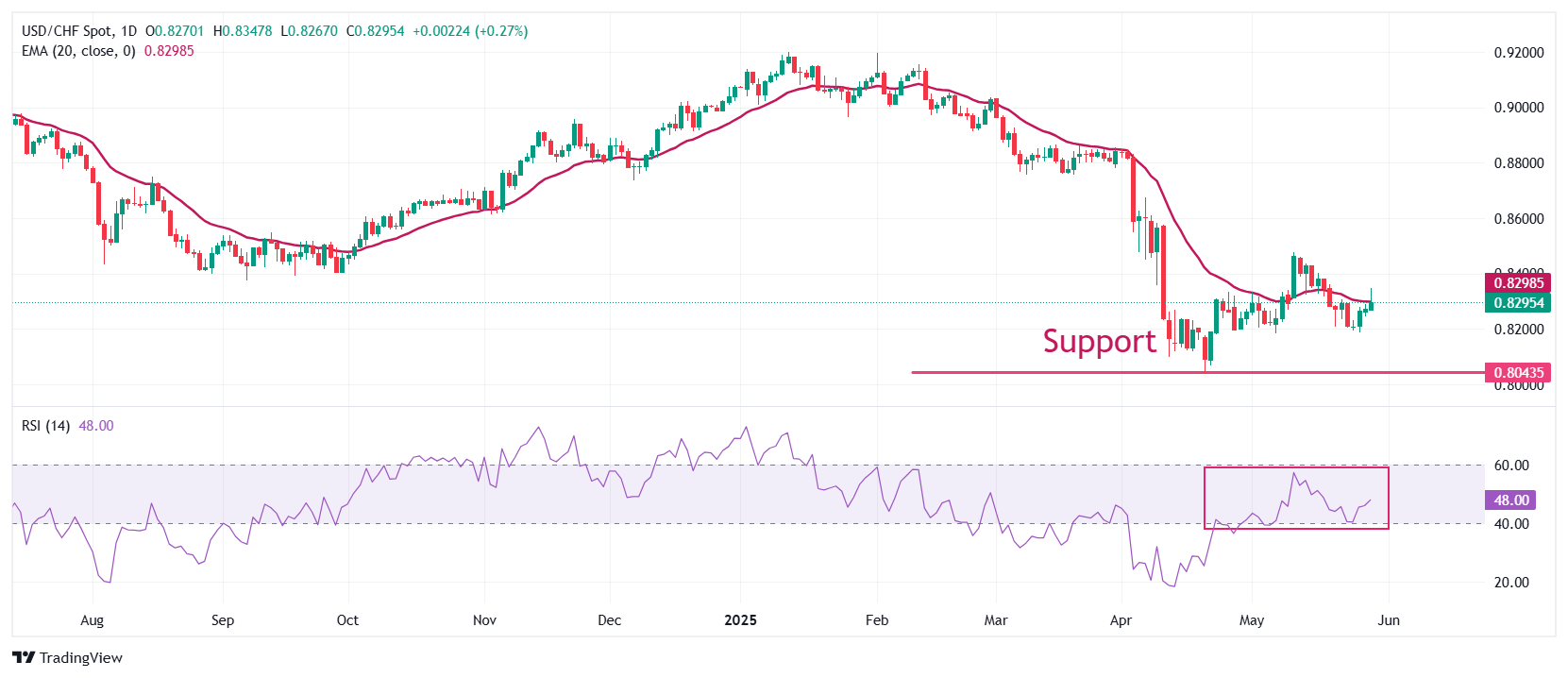USD/CHF Pride Forecast: Retraces below 0.8300
USD/CHF gives back the majority of early gains as the US Dollar retreats.
US President Trump faces legal challenges in fulfilling his tariff agenda.
The US court orders the administration to lift reciprocal tariffs, fentanyl, and immigration-related import duties.
The USD/CHF pair gives up a significant part of its initial gains and falls below 0.8300 during European trading hours on Thursday, from the intraday high of 0.8348. The Swiss Franc pair falls back as the US Dollar (USD) retreats in the aftermath of the United States (US) Court of International Trade’s verdict against President Donald Trump using the International Emergency Economic Powers Act (IEEPA) to impose tariffs on all of his trading partners.
The US Dollar Index (DXY), which tracks the Greenback’s value against six major currencies, surrenders a majority of its early gains after facing resistance above 100.50 and falls back to near 100.00.
Earlier in the day, the Manhattan-based court cited Trump’s decision to invoke IEEPA to justify the imposition of higher import duties to fix large trade imbalances as unlawful. To rectify the same, the court issued a 10-day deadline to the administration for the permanent injunction of reciprocal tariffs announced on the so-called Liberation Day, and those imposed on its North American peers and China regarding border negligence and fentanyl.
Meanwhile, the Swiss Franc (CHF) underperforms amid fears that the Swiss National Bank (SNB) could push interest rates into negative territory to offset downside risks to inflation.
USD/CHF retreats after facing selling pressure above the 20-day Exponential Moving Average (EMA), which trades around 0.8300.
The 14-day Relative Strength Index (RSI) strives to hold the 40.00. A fresh bearish momentum would activate if the RSI falls below that level.
The asset could slide towards the April 11 low of 0.8100 and the April 21 low of 0.8040 if it skids below the May 7 low of 0.8186.
On the contrary, a recovery move in the pair above the psychological level of 0.8500 will open the door for more upside towards the April 10 high of 0.8580 and the April 8 high of 0.8611.
USD/CHF daily chart

US Dollar FAQs
The US Dollar (USD) is the official currency of the United States of America, and the ‘de facto’ currency of a significant number of other countries where it is found in circulation alongside local notes. It is the most heavily traded currency in the world, accounting for over 88% of all global foreign exchange turnover, or an average of $6.6 trillion in transactions per day, according to data from 2022. Following the second world war, the USD took over from the British Pound as the world’s reserve currency. For most of its history, the US Dollar was backed by Gold, until the Bretton Woods Agreement in 1971 when the Gold Standard went away.
The most important single factor impacting on the value of the US Dollar is monetary policy, which is shaped by the Federal Reserve (Fed). The Fed has two mandates: to achieve price stability (control inflation) and foster full employment. Its primary tool to achieve these two goals is by adjusting interest rates. When prices are rising too quickly and inflation is above the Fed’s 2% target, the Fed will raise rates, which helps the USD value. When inflation falls below 2% or the Unemployment Rate is too high, the Fed may lower interest rates, which weighs on the Greenback.
In extreme situations, the Federal Reserve can also print more Dollars and enact quantitative easing (QE). QE is the process by which the Fed substantially increases the flow of credit in a stuck financial system. It is a non-standard policy measure used when credit has dried up because banks will not lend to each other (out of the fear of counterparty default). It is a last resort when simply lowering interest rates is unlikely to achieve the necessary result. It was the Fed’s weapon of choice to combat the credit crunch that occurred during the Great Financial Crisis in 2008. It involves the Fed printing more Dollars and using them to buy US government bonds predominantly from financial institutions. QE usually leads to a weaker US Dollar.
Quantitative tightening (QT) is the reverse process whereby the Federal Reserve stops buying bonds from financial institutions and does not reinvest the principal from the bonds it holds maturing in new purchases. It is usually positive for the US Dollar.
